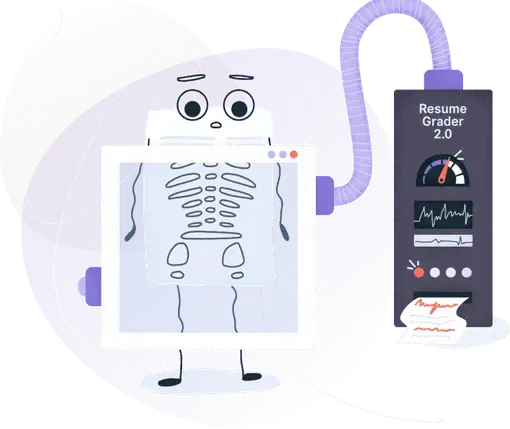Bpm Skills: Example Usage on Resumes, Skill Set & Top Keywords in 2025
Including BPM (Business Process Management) on your resume suggests that you are adept at improving efficiency and capable of optimizing business processes. Dive into the guide below to refine your resume and discover valuable skills and alternate terms that can impress potential employers.


Is your resume ATS-friendly?
Drop your resume here or upload a file to find out if the skills in your resume are readable by an ATS.
"BPM" stands for Business Process Management. It is a skill that allows you to streamline a company's operations by improving the processes that keep the business running. Having BPM on your resume shows that you can identify, evaluate, and improve business processes, which can make an organization more efficient and effective. This skill can also indicate that you understand how different parts of a business connect with each other and how to optimize these connections for better performance.
However, there can be downsides to including BPM on your resume. One potential drawback is that if it's not a core requirement for the job you're applying for, it might not add significant value to your application. Furthermore, simply listing "BPM" without context or examples of how you've successfully applied this skill can be too vague and fail to impress employers. Instead, it can be more effective to highlight specific projects or achievements that demonstrate your BPM abilities in action, providing concrete examples of how you've used BPM to improve a business's operations.
In this article, you will learn:
- How to give specific examples of BPM in a professional setting.
- The disadvantages of having BPM on your resume if it's not relevant to the job.
- Alternative skills that could complement BPM on your resume.
Misusage of bpm on resumes
Business Process Management (BPM) skill is crucial for enhancing operational efficiency, but it can be misrepresented on a resume, reducing its impact and credibility. To make your BPM expertise stand out, it's important to present it accurately across all sections of your resume.
- In the summary section: Do not overstate your abilities by claiming, "Revolutionized company workflow by single-handedly implementing BPM strategies that increased productivity by 500%," when the improvement was a team effort and the percentage is exaggerated.
- In the experience section: Avoid vague assertions such as, "Used BPM in daily tasks," instead, provide specific examples of how you applied BPM tools or methodologies to optimize processes.
- In the achievements section: Do not attribute all successes to BPM without acknowledgment of other factors, as in, "Solely through BPM implementation, cut project costs in half," when multiple approaches were employed to reduce expenses.
How to demonstrate bpm skills on your resume
- List specific BPM tools you have experience with, such as IBM Blueworks, Signavio, or ARIS, and describe the projects or processes you improved using these tools.
- Include quantifiable achievements, for example, "Streamlined the customer service process, resulting in a 20% reduction in response time."
- Highlight any certifications you hold, such as BPM CBPA or CBPP, to establish your formal training and knowledge in process management.
- Detail your understanding of BPM methodologies like Lean or Six Sigma by mentioning how you applied them in past roles to enhance efficiency and effectiveness.
- Reflect on any cross-functional team leadership or collaboration experience, emphasizing your ability to communicate with and coordinate between different departments for process optimization.
Example 1: Demonstrate bpm in the experience section
- •Implemented a new project management software that boosted productivity by 20% within the first year.
- •Led a team of analysts to redesign workflow processes, resulting in a 15% reduction in operational expenses over two years.
- •Developed a comprehensive training program for new hires that improved retention rates by 25%.
- •Collaborated on an inter-departmental initiative to streamline quarterly reporting, reducing time spent by 35%.
- •Managed business requirement gathering for a major software update, improving customer satisfaction scores by 30% post-implementation.
- •Conducted in-depth data analysis that identified key performance blockers, leading to strategic adjustments.
- •Delivered a strategic plan for a manufacturing client that elevated production output by 40% within two years.
- •Identified redundancies in a client’s inventory system, proposing a solution that saved $500,000 annually.
- •Led a risk assessment for a healthcare provider that improved compliance with industry regulations by 100%.
- Showcase measurable results – each bullet point includes clear metrics that demonstrate the impact of your work.
- Each experience is relevant, tied to clear business outcomes, and showcases specific projects and the candidate's active role in those projects.
- Bullet points employ a variety of language to paint a detailed picture of your diverse skill set and how it was applied in different scenarios.
- Use recent and accurate dates that reflect continued growth and relevance in your career.
- Provide a comprehensive insight into responsibilities and successes without overusing clichés and avoiding vague statements.
Example 2: Demonstrate bpm in the summary section
- The summary directly states the candidate's experience and a quantifiable achievement.
- Skills are mentioned without the use of buzzwords, focusing on the instruments handled, like Appian and Visio.
- The text provides a sense of the candidate's passion without using clichés or fluff.
- It gives a true representation of the individual's background, concisely illustrating their capabilities and experiences.
- This approach prevents the overuse of common phrases, sticking to straightforward and effective communication.
To craft a resume summary with Excel skills:
- Begin with the number of years of experience, highlighting your dedication to the field.
- Reflect your enthusiasm for work by sharing a personal success story or key milestone from your career.
- Discuss relevant technical skills clearly, such as proficiency with Excel functions, pivot tables, and macros.
- Avoid generic phrases and instead present your understanding through clear examples.
- Each sentence should offer insight into your competencies and enthusiasm for your profession.
Example 3: Demonstrate bpm in the achievements section
- The achievements focus on specific, measurable results, demonstrating the applicant's direct impact on their work environment.
- Descriptions are concise and highlight concrete outcomes, avoiding vague or overused jargon that could dilute the message.
- Title lengths are kept short and to the point, making it easy for readers to quickly identify the key accomplishments.
- Effective use of numbers offers tangible evidence of the applicant's success in their previous roles.
- Each achievement is related to a real work situation, providing a clear and relatable context.
- The writing style avoids overused words and phrases, leaning on simple language that clearly conveys the message.
- Directly addresses your needs by using a "you" "your" style that engages the reader and keeps their attention.
What are the relevant certifications for bpm skills on resume
Here are some respected certificates in the field of Business Process Management (BPM), which will validate your expertise and help expand your professional capabilities.
The top 5 certifications for gaining bpm skills expertise:
This certificate demonstrates your knowledge in BPM principles and practices and prepares you to contribute effectively to business process improvement initiatives.
<li><strong>OCEB 2 Certification (OCEB™)</strong> - Object Management Group (OMG)
<br>The OCEB 2 certification covers fundamental and technical BPM concepts, helping you to apply BPM techniques in solving business problems with technology.</li>
<li><strong>Certified Business Process Leader (CBPL)</strong> - AIIM
<br>CBPL is designed for leaders who aim to oversee BPM strategies in their organizations, equipping you with skills to drive and manage change effectively.</li>
<li><strong>Certified Business Process Associate (CBPA)</strong> - AIIM
<br>This entry-level certificate focuses on BPM practices and is ideal if you're looking to understand and work with business process improvement projects.</li>
<li><strong>BPM Certification</strong> - BPMInstitute.org
<br>Offered at various skill levels, these certifications show you how to enhance processes using BPM tools and techniques, making you valuable in any process-focused role.</li>
Top skills people add together with bpm skill on resume:
Process Improvement
Project Management
Lean Six Sigma
Workflow Analysis
Enterprise Resource Planning (ERP)
Customer Relationship Management (CRM)
Data Analysis
Process Mapping
Quality Assurance
Performance Measurement
Problem Solving
Analytical Thinking
Collaboration
Communication
Leadership
Time Management
Adaptability
Attention to Detail
Decision Making
Critical Thinking
Organizational
Most relevant jobs for bpm skills
- Business Process Manager: This role focuses on managing and optimizing a company's business processes for efficiency and effectiveness.
- Business Analyst: Professionals in this position analyze business processes and recommend improvements to facilitate better workflow and results.
- Process Improvement Consultant: This job involves working with organizations to streamline operations, reduce waste, and ensure processes meet business objectives.
- Business Process Architect: This role is responsible for designing and implementing business process architecture to support organizational goals.
- Operations Manager: They oversee the production of goods and services and work to improve the efficiency of business operations.
- Project Manager: This position requires coordinating with teams to successfully execute projects, often involving process change or improvement.
- Quality Assurance Manager: QA managers concentrate on maintaining the quality of processes, ensuring that standards are met throughout production or service delivery.
- Change Management Specialist: These specialists help guide businesses through changes in processes or systems, ensuring smooth transitions and employee buy-in.
- Compliance Manager: They are tasked with making sure that company processes adhere to legal and regulatory requirements.
- Enterprise Architect: This job involves the planning and implementation of a cohesive framework of business processes and technologies.
Key takeaways
- BPM stands for Business Process Management, a skill that can enhance your resume by showing your ability to improve operational efficiency.
- Avoid misusing BPM skills by not overcomplicating processes or implementing changes without proper analysis.
- Showcase your BPM expertise on your resume by highlighting specific improvements you've made, metrics you've improved, or processes you've optimized.
Make one that's truly you.




